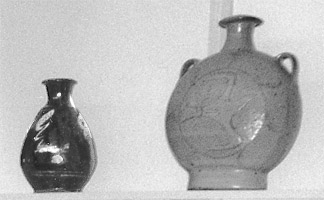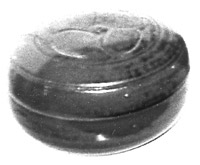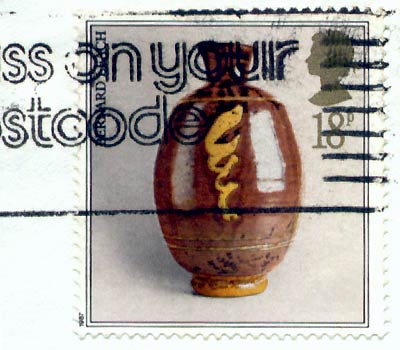| Ceramics | U.K. | ||||||||||||||||||||||||||||||||||||||||||||||
BAFA © 2010. All material here is copyrighted. See conditions above. |
Bernard Leach
ceramics, (Japan) U.K. |
|
This text by Sonja van Kerkhoff is extracted from the books mentioned. Bernard Leach was born into a wealthy British family in Hong Kong. His mother died at childbirth and his father was a colonial judge. Bernard Leach first lived in the U.K. when he started studying at Jesuit boarding school near Windsor in 1897. In 1903 he entered the Slade School of Art to study under Henry Tonks and there met the South African student Reginald Turvey who became his life-long friend, and who also in later years became a Bahá´í. He also took some classes in etching. During these years he also met the Japanese Zen Buddhist art student Kotaro Takamura, another life-long friend who became a known sculptor, poet and art critic in Japan.
|
 photo of Bernard Leach to come |
Everything dripped! - frogs croaked - even insects took refuge indoors and produced a kind of music. Human beings also had inclinations towards musical expression…
Some daughter of a neighbouring house plucked despairing notes from a thirteen-stringed horizontal harp - a koto - very melancholy. A group of men sang at night the choruses of noh drama in unison - sonorous, with a seriousness reminiscent of plainsong. The induced mood was poetic. I began to read two-lined translations of Japanese haiku…" page 43, "Beyond East and West" by Bernard Leach, Faber & Faber, 1978, 1985. |
In 1913 Bernard was then invited by Kenzan to have his own kiln and workshop, and one day he invited an architect friend of his, Kenkichi Tomimoto, to throw his first pot which a week later Tomimoto decorated with the verse: "The nightingale sings amongst plum blossoms once again, hokekkyo! hokekkyo!", which was the same ballad that the first Kenzan put on one of his pots 200 years earlier. Both of these pots were given to Bernard and now they are in the collection of the Victoria and Albert Museum in London. After a few years Tomimoto and Leach were so valued by the sixth Kenzan that they were given the glaze recipes as the next generation of Kenzan potters. (see Bernard Leach's 1966 book "Kenzan and his Tradition")

photo of Bernard Leach in Japan or work made in those years to come |
It was during these years that Leach developed his theories about East and West, where the west represented the material (the intellect) and the East represented spirituality and intuition. "Ever since my early twenties in Japan I have been increasingly aware of that which is loosely called East and West. Early on, I thought of this as opposition, later I came to see the relationship as complementary… I was driven to this conclusion not primarily by theory, but through my own experience in art, born of the life which surrounded me… Art, as we endeavour towards perfection, is one with religion, and this fact is better recognized in the East… Buddhism does not speak of God but of "Thusness" (Things as they really are)… All from West to furtherest East are unitive and not dualistic. Our dualism commenced when we separated intellect from intuition… " "Drawings, Verse and Belief" by Bernard Leach, Oneworld Publications, U.K. 1988, pages 9 - 10. |
Bernard Leach expressed many of his thoughts on spirituality and art in his letters and articles throughout his life and some of these are reproduced in Rob Weinberg's "Spinning the Clay into Stars", Lowell Johnson's "Reginald Turvey - Life and Art", and his own "Beyond East and West" and "Drawings, Verse and Belief". The agnosticism of his youth had evolved to a sense of spiritually of a more oriental approach. Leach mentions in his 1953 self-published essay, My Religious Faith, that he first heard of the Bahá´í Faith just before World War One, from the American Agnes Alexander, living in Japan. |
| In 1920 Leach moved with his family of three children, (Twin daughters were born just after they arrived.) and the Japanese potter Shoji Hamada to St. Ives in Cornwall (U.K.) sponsored by Mrs Frances Horne, who had set up a Craft Guild in the area.
"When we started in Cornwall neither Hamada nor I had any experience of crafts in England. Our ideas were more or less bounded by conditions of craftmanship in Japan. The conclusion we came to was that making and planning round the individuality of the artist was a necessary step in he evolution of the crafts. So at St. Ives, at the outset, we based our economics on the studio and not on the country workshop, or, for that matter, the factory. |

Pots by Bernard Leach in the St. Ives pottery. Detail of a photograph: Robert Weinberg, U.K. from the book, "Spinning the Clay into Stars", George Ronald, U.K. 1999. |

A plate by Bernard Leach in the St Ives pottery. Detail of a photograph: Robert Weinberg, U.K. from the book, "Spinning the Clay into Stars", George Ronald, U.K. 1999. |
Hamada and I laid the foundations for an Oriental climbing stoneware kiln - the first of its kind in the West... When building the pottery workshop in the aumumn of 1920, we left a small corner area for a bedroom, which was first occupied by Hamada and later by Michael Cardew. "Page 139, "Beyond East and West" by Bernard Leach, Faber & Faber, 1978, 1985.
|
|
In 1920 Hamada was 25 and I was 33: he had not yet exhibited whilst I had been launched in his country as an artist and potter for ten years. He had had a scientific training, but I had made mistakes and thereby gained some experience. Like his own pots, he was well ballasted. For three years we shared a good partnership. The background of thought which we brought to the undertaking was that of the artist turned craftsman; or at least of the educated and thinking man perceiving the simple beauty of material, workmanship and general approach to work which had preceded the Industrial Revolution. His desire, as was mine, was to recapture some of the lost values through the use of his own hands. So it was with William Morris, Gimson, and Edward Johnston. East or West, this is the counter-revolution, the refusal of the slavery of the machine... " Pages 143-4, "Beyond East and West" by Bernard Leach, Faber & Faber, 1978, 1985.
In 1922 we were joined by Tsuneyoshi Matsubayashi, engineer, chemist and crafsman-potter of the thirty-ninth generation of a well-known family of potters. Hamada returned to Japan in 1923, and Matsubayashi the following year. At this stage we were making a lot of rather uneconomic experiments in the Japanese low-temperature faience, raku, in middle temperature English slipware and in high-temperature Oriental stoneware and hard porcelain. We were still using wood, and there were many occasions when the beginner's struggle with the unforeseen, without the experience and advice of old hands, made me realize the truth behind the friendly warning that in Japan twenty years were regarded as about the time requisite for the establishment of a new pottery. I remember one firing in about 1924 which lasted twice as long as usual - 72 hours. In all that time I had only two hours off, and could hardly stand up at the end... Page 145, "Beyond East and West" by Bernard Leach, Faber & Faber, 1978, 1985.
|
| Leach was appalled by the lack of interest in art pottery there but they forged ahead, surviving on sales in Japan where Leach had a name but after 3 three years, a serious earthquake in Japan, ended that financial support. Leach had to find a way to make his work more saleable to the British market, where pottery was not valued as an art form. He focussed on household objects and changed his attitudes towards production and the role of machinery. He also took in students who did a lot of the production work.
Michael Cardew was the first student in 1923 (staying until 1926), followed 6 months later by Katherine Pleydell-Bouverie, and Norah Braden in 1925 after Katherine had left. His son, David joins the pottery in 1930 and becomes the manager of the pottery in 1937 and partner in 1946. |

Pots by Bernard Leach in the St. Ives pottery. Detail of a photograph: Rob Weinberg, U.K. from the book, "Spinning the Clay into Stars", George Ronald, U.K. 1999. |

Lidded Container by Bernard Leach in the St Ives pottery. Detail of a photograph: Rob Weinberg, U.K. from the book, "Spinning the Clay into Stars", George Ronald, U.K. 1999. |
In 1932 Bernard Leach was offered a teaching position at Dartington Hall, where he became friends with another teacher there, Mark Tobey and learns of the Bahá´í Faith from him.
Years later in 1940 at a public meeting in Torquay, Bernard Leach asked Hasan Balyuzi if it was sufficient to consider Bahá'u'lláh a spiritual genius and on hearing "yes", he then declared that he was a Bahá´í (page 21,"Spinning the Clay into Stars"). |
In 1934 Bernard Leach travelled to Japan and the benefactors of Dartington Hall, Dorothy and Leonard Elmhirst, paid for Mark Tobey to be able to travel with him to Hong Kong.
|

Detail of a plate design, pen and wash, by Bernard Leach, 1954. Photograph: Rob Weinberg, U.K. from the book, "Spinning the Clay into Stars", George Ronald, U.K. 1999. |
underlying it and my criticism of the contemporary Japanese movement which I had initiated twenty odd years ago, and which has grown up under Yanagi's wing. He particularly asked me to try to explain why even the best of modern pots fall far behind the standards of the past, especially that of the Sung era in China and Korea..."
Page 195, "Beyond East and West" by Bernard Leach, Faber & Faber, 1978, 1985.
Leach also travelled to Korea in 1935. "I remember with what enthusiasm I saw the imperial collection of pots in Korea before they were dispersed by war. The ones I at first loved most were celadons of the twelfth and thirteenth centuries, many delicately inland with white and black patterns. ...their grey-green was described as 'the colour of the sky after rain'. These quiet pots were made for a cultured Buddhist society of the Koryo Dynasty... Everywhere in this peninsula I found a lonely, poetic beauty. From the first if my concept of China has been of form, that of Korea has been of line, whether in landscape, hats, shoes, pottery or poetry..." On his return in 1936 Bernard Leach moves with his secretary and former student, Laurie Cookes, who he marries in 1944, to Ditchling (Sussex), then Winchling and finally to Dartington. The Second World war "were the rough years for us all. In addition there was the question of how to make ends meet. At the Government's request but at our own expense a committee gathered monthly in the National Gallery in Trafalgar Square to do what it could for the remaining craftsmen of England, for the sake of the future. The present Crafts Centre is the residue of those efforts - originally under John Farleigh, C.B.E., and later Sir Charles Tennyson. Twice when we were short of labour I appealed successfully to tribunals for the direction of young art students who were genuine conscientious objectors. That decision helped... Richard Kendall became a good teacher at Camberwell College of Art... The other, Patrick Heron... ...Our Pottery cottage was roofless and uninhabitable for three years whilst I fought red tape to get permission for repairs, for which we had the material and old men's labour... ...Two of my students, who had grown beards, were promptly thought disloyal by Cornish neighbours. We were even accused of signalling to the Germans with our kiln-fires, even though our kilns had not been used for months.. ...we could sell whatever useful pots we made during the dearth of the War... because of a shortage of manpower in the potteries etc., distributors in London were selling hand-made pots for use; thus conditions of war to some extent caused us to change course... I made the prototypes, drew them on cards with measurements attached, and these were handed out to whoever was making cups, saucers, bowls, jugs, etc. Naturally the price of our plain household pots was less than for those we had supplied to art galleries, so we had to take steps to increase production. In long retrospect I think this was a very healthy change because it preserved a useful connection with the demands of life itself... " Page 219 - 222, "Beyond East and West" by Bernard Leach, Faber & Faber, 1978, 1985.
|
In 1952 he organized the International Conference of Craftsmen in Pottery and Textiles with 110 selected delegates from Africa, Ameria, Asia and Europe. "My idea of an East and West meeting and interchange was supported and welcomed...
Intimate exchange was already taking place within a few hours; groups formed spontaneously, depsite variety of language. There were constant lectures, films, and demonstrations of pottery and weaving. It was evident that a great of intercommunication was being filled...
Apart from the general pleasure and enthusiasm of this unprecedented international conference, it produced widespread repercussions. The Arts Council sent the exhibition of twenty-five years of English studio pottery and textile on tour in Great Britian. I arranged to travel across the United States with Hamada and Yanagi, lecturing, demonstrating, and discussing the problems raised at Dartington...
...the companionship of two such remarkable Orientals carrying a Buddhist philosophy and aesthetic, was unique...
...We told them incessantly that secrecy about glazes was sheer nonsense and that we had none, but if they would put first things things first, we would tell them about the materials and the principles upon which they could put them together for themselves. We explained that most wood or vegetable ash would cause clays and powdered rocks to melt into a sort of glass: they were astonished and remarked, 'But how simple.'
'No', said Hamada, 'much more complex because the chemical composition of such raw materials including ashes, varies with the locality and the season of gathering.'
We talked to them about hakeme Korean stoneware pots - a method of combining or brushing white slip over a grey body - of which they had seen photos - so they naturally wanted to learn how this was done. Walking to the canteen for lunch one day, Hamada gathered some coarse wayside grasses in seed, made a bunch out of the long stalks as we sauntered along, bound the butt ends with thin string, and said, 'I think that will do.' Then he took some half-dried bowls he had thrown the previous day, dipped either the inside or outside in white slip, put one at a time more or less accurately in the centre of the wheel and turned it slowly and combed the wet surface swiftly with the bunch of weeds. Thse American students were astonished by his close-to-nature, nonchalent treatment. Some smiled: Hamada looked up and said, 'Simple, but not simple.' They laughed outright. Those few seconds established a meeting-point between East and West in America."
Pages 242-45, "Beyond East and West" by Bernard Leach, Faber & Faber, 1978, 1985.
Leach and Hamada also visited the New Mexican potters, Maria Martinez and her son Popovi Da.
Leach travels widely over the next decade, including a trip to New Zealand in 1962 where he visits the pottery of Barry Brickell and meets 'man of the trees' Richard St. Barbe Baker, another Bahá´í, in Timaru.
|  Thanks to Alan Bell for lending us this stamp. |
|
Arts Dialogue, Dintel 20, NL 7333 MC, Apeldoorn, The Netherlands email: bafa@bahai-library.com |